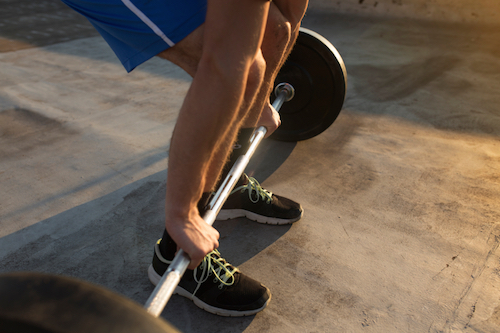Integrated Strength Training
Integrated Strength Training is a systematic, integrated and functional training program that simultaneously improves biomotor abilities, and builds high levels of functional strength, neuromuscular efficiency and dynamic flexibility.
The OPT Model™ developed by The National Academy of Sports Medicine is a phase-specific, integrated training program designed to produce consistent physical, physiological and performance improvements in every individual.
The components of Integtrated Training include flexibility, core strength, balance, power, functional strength, and speed.
Functional strength development requires a program that is multi-dimensional, multiplanar, proprioceptively enriched, activity specific, and progressive.

2 Principles of Integrated Strength Training
- Overload- Forces progressive adaptation. (Specific Adaptations to Imposed Demand). Occurs through Acute Variable Manipulation. (variables such as reps, sets, intensity, volume, tempo, recovery time, and stability requirement)
- Variation- enables continuous adaptations to occur over a training period. (periodized)
Size Vs. Strength in in Integrated Strength Training
High Volume Training = Cellular change and hypertrophy. (1:2 work/rest ratio)
High Intensity Training = Neural Adaptation, strength and power. (1:5-1:12 work/rest ratio)
| Acute Variables | Power (Speed) | Max. Strength | Hypertrophy | Endurance |
| Repetitions | 1-10 | 1-5 | 8-12 | 12-25 |
| Sets | 3-6 | 4-6 | 3-4 | 1-3 |
| Intensity | 30-45% or up | 85-100% | 75-85% | 40-70% |
| Volume | 6-30 reps/exer. | 4-20 reps/exer. | 24-36 reps/exer. | 36-75 reps/exer. |
| Tempo (Time Under Tension) | x/x/x (explosive) | x/x/x (explosive) | 3/2/1 - 1/1/1 | 4/2/2 - 4/2/1 |
| Rest Interval | 3-5 min | 3-5 min | 45-90 sec | 0-90 sec. |
Specificity, Individualization and Progression
Specificity - the more similar the exercise is to the actual activity (movement speed, rate of force production, movement pattern specificity, bioenergetic specificity, postural specificity, etc.) the greater the transfer-of-training effect. Specificity should be in contraction velocity (repetition tempo) and movement pattern specificity (dynamic correspondence).
Individualization - variables specific for the individual (age, medical history, injury history, training background, work capacity, recoverability, goals and structural integrity).
Progression - progressive training principles are designed to:
- Develop proper muscle balance
- Correct kinetic chain imbalances.
- Develop proper structural integrity of the kinetic chain.
- Develop stabilization strength, core strength and neuromuscular efficiency prior to extremity strength, prime mover strength and explosive strength.
- Establish optimum levels of activity specific functional strength, neuromuscular efficiency, reactive neuromuscular control and power.
4 Types of Strength
Strength is the ability of the neuromuscular system to produce internal tension and exert resistance against an exertional force.There are 4 types of strength that we are going to fucus on.
1. Maximal Strength - the maximum force a muscle can produce in a single voluntary effort, regardless of rate of force production
- Limited by neuromuscular inhibition. Improved through core stabilization and balance training. (Improves intra and inter-muscular coordination.
- Intramuscular coordination- ability of the neuromuscular system to allow optimum levels of motor unit recruitment and motor unit synchronization, allowing high levels of force reduction, stabilization, and force production.
- Intermuscular coordination- ability of the neuromuscular system to allow agonists, antagonists, synergists, stabilizers and neutralizers to work synergistically in an integrated, multi-planar environment.
2. Endurance Strength - the ability to maintain force over a prolonged period of time.
3. Speed Strength - (Power) - the ability to produce the greatest force in the shortest possible time.
There are three components of speed strength.
Starting strength- depends on intramuscular and intermuscular coordination. (how quickly you can begin the movement)
Explosive strength- ability to develop sharp rise in force production once the movement pattern has been initiated. (middle of the movement)
Reactive strength- (Plyo) ability of the neuromuscular system to switch from an eccentric contraction to a concentric contraction quickly (amortization phase)
4. Stabilization Strength - ability to provide optimal dynamic joint stabilization and maintain postural equilibrium during functional movements. Allows for optimum recruitment of prime movers, increased force production and force reduction.

7 Phases of Integrated Strength Training
Phase #1- Corrective Exercise Training (Muscle Balance)
- Focus is on correction of muscle imbalances, joint dysfunctions, neuromuscular deficits and postural distortion patterns. Also to recondition injured anatomical locations, and prepare non-contractile tissue for upcoming imposed demands of training.
- Compensations will lead to adaptations through the kinetic chain which must be corrected in order to prevent injury, before implementing an aggressive integrated training program.
| REPS | SETS | TEMPO | INTENSITY | REST INTERVAL | FREQUENCY | DURATION | EXERCISE SELECTION |
| 15-25 | 1-3 | 4/2/2 | 40-60% | 0-90 sec. | 1-5x/week | 1-6 weeks | 0-2 Stabilization |
Phase #2- Stabilization Endurance Training (Endurance)
- Goal is to increase strength and develop optimal neuromuscular efficiency so to create optimum levels of stabilization strength and postural control.
- Improves segmental stability by altering proprioceptive demands versus increasing external resistance. Allows for extremity mobility with spinal stability.
- Training is done in a multiplanar, proprioceptively enriched environment.
| REPS | SETS | TEMPO | INTENSITY | REST INTERVAL | FREQUENCY | DURATION | EXERCISE SELECTION |
| 12-20 | 2-3 | 4/2/1 | 60-70% | 0-90 sec. | 2-4x/week | 4 weeks | 1-2 Stabilization |
Phase #3- Stabilization Strength Training (Strength)
- Stabilization strength and endurance during functional movement patterns.
- Enhance motor unit recruitment after prime movers have fatigued.
- Improve overall work capacity and metabolic efficiency with increased training volumes.
- Each resistance training exercise is a SUPERSET of a strength level exercise followed immediately by a stabilization level exercise. (high volume/cellular training)
| Reps | Sets | TEMPO | INTENSITY | REST INTERVAL | FREQUENCY | DURATION | EXERCISE SELECTION |
| 8-12 | 3-4 | STR. 2/0/2 STAB. 3/2/1 | 70-80% | 0-60 sec. | 3-5x/week | 4-6 weeks | 1 STR. and 1 STAB. |
Phase #4- Muscular Development Training (Hypertrophy)
- Improves cross-sectional area and alter body composition
- Involves High Volume, body-part-specific training (rather than proprioceptive, stabilization training)
- Designed specifically for hypertrophy, not performance improvements
- Large Muscle Mass exercises (Bench, squat), 2-4 exercises per body part (24-36 sets.
- Alternate heavy with light days. Can use split routines or other routine variations.
| Reps | Sets | TEMPO | INTENSITY | REST INTERVAL | FREQUENCY | DURATION | EXERCISE SELECTION |
| 6-12 | 3-5 | 2/0/2 | 75-85% | 0-60 sec. | 3-6x/week | 4 weeks | 2-4 Strength |
Phase #5- Maximal Strength Training (Power)
- Designed for people who need to increase maximal strength.
- May not be appropriate for everybody; keep in mind importance of specificity of training. Most functional activities require increased rate of force production, not increased force production.
- Designed to increase motor unit recruitment, frequency of motor unit recruitment, motor unit synchronization and improved peak force.
- Improved power production (increased rate of force production) in individuals with high levels of maximum strength.
- Requires insertion of power movements.
| Reps | Sets | TEMPO | INTENSITY | REST INTERVAL | FREQUENCY | DURATION | EXERCISE SELECTION |
| 1-5 | 4-6 | x/x/x | 85-100% | 3-5 min. | 2-4 x/week | 4 weeks | 1-3 strength |
Phase #6- Elastic Equivalent Training (Plyometric)
Combines a strength exercise with a biomechanically comparable power exercise.
- Enhances neuromuscular efficiency and rate of (power) force production.
- Improves motor-neuron excitability and reflex potentiation.
- Improves rate of force production with high-velocity training.
- A reactive exercise performed immediately after the strength exercise elicits additional neuromuscular adaptation (increases motor-unit recruitment, rate coding, motor-unit synchronization and rate of force production).
| Reps | Sets | TEMPO | INTENSITY | REST INTERVAL | FREQUENCY | DURATION | EXERCISE SELECTION |
| 1-5 (S) 8-10 (P) | 3-5 | X/X/X | 85-100% (S) 30-45% up to 10% BW (P) | 1-2 min. b/t pairs. 3-5 min. b/t circuits | 2-4 x/week | 4 weeks | 1 Strength and 1 Power |
Phase #7- Maximal Power Training (Speed)
- Developed by training 30-45% of maximum strength and by accelerating through the entire range of motion.
- Should only be implemented with those who require max. speed strength and have already developed optimum levels of stabilization strength and eccentric strength.
- Designed to develop speed strength and create neuromuscular adaptations through the entire range of motion.
- Allows individuals to express their speed strength through the entire range of motion. (Improves concentric, eccentric (25-40%) and isometric explosive power).
| Reps | Sets | TEMPO | INTENSITY | REST INTERVAL | FREQUENCY | DURATION | EXERCISE SELECTION |
| 1-5 (P) | 4-6 | X/X/X (Explosive) | 30-45% or up to 10% BW | 3-5 min. b/w circuits | 1-2x/ week | 2 weeks | 1 Power |
References:
NASM: Essentials of Personal Fitness Training, 3rd Ed. (2008)
Clark, M. & Russell, A. Optimum Performance Training for the Performance Enhancement Specialist (3rd Ed.) National Academy of Sports Medicine.
The Integrated Training Series
- Integrated Dynamic Fitness Training
- Integrated Flexibility Training
- Integrated Core Training
- Integrated Balance Training
- Integrated Plyometric Training
- Integrated Speed, Agility, Quickness Training
- Integrated Strength Training
Latest X Factor post
Is your body saying you're old, but your mind isn't willing to give in? If you've ever felt discouraged by the challenges of health & fitness after 40, we've got a few tips, and a toolbox to help.
View BlogReceive "20 Ideas to Streamline Your Wellness Routine."
 Sign up for our "Weekly Wellness Tip" and get your free report "Simple Choices, Lasting Changes: 20 Ideas to Streamline Your Wellness Routine." The report gives you simple, smart ideas that can help you feel better and be more productive during your work day.
Sign up for our "Weekly Wellness Tip" and get your free report "Simple Choices, Lasting Changes: 20 Ideas to Streamline Your Wellness Routine." The report gives you simple, smart ideas that can help you feel better and be more productive during your work day.

Leave a Comment
Comments (0)